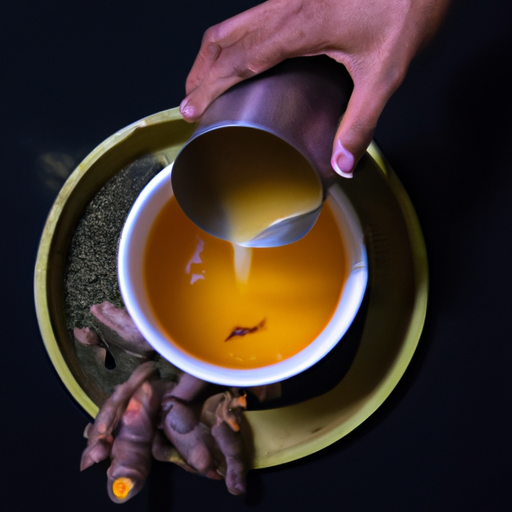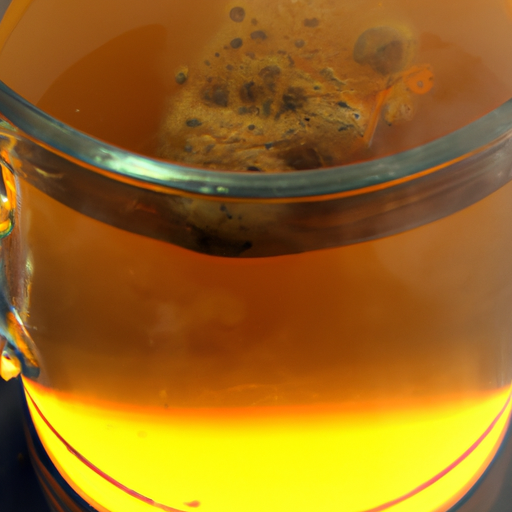Turmeric tea, made from the vibrant yellow root, has long been revered for its numerous health benefits. As a believer in the power of natural remedies, I have discovered the beauty of turmeric tea and its ability to promote overall well-being. This ancient elixir has been used for centuries in traditional Ayurvedic medicine and is known for its anti-inflammatory and antioxidant properties.
But how is turmeric tea made from turmeric? In this article, I will guide you through the process of selecting the best turmeric root, preparing it for tea, and brewing the perfect cup. We will also explore the benefits of allowing the tea to steep, the importance of straining and serving it correctly, and the variations you can explore to suit your taste.
So, let’s delve into the world of turmeric tea and unlock its secrets for a healthier, more balanced life.
Key Takeaways
- Turmeric tea is made from the vibrant yellow turmeric root, which is known for its anti-inflammatory and antioxidant properties.
- Organic turmeric is recommended for making turmeric tea as it is free from pesticides and harmful chemicals.
- Turmeric tea can be made by grating or slicing the turmeric root, boiling it in water for about 10 minutes, and adding additional ingredients like black pepper, lemon, or honey for flavor and enhanced benefits.
- Regular consumption of turmeric tea may promote a healthier lifestyle by reducing inflammation, supporting immune function, and promoting healthy digestion.
Selecting the Best Turmeric Root
To make the best turmeric tea, you’ll want to start by selecting the freshest and most vibrant turmeric root available. When selecting organic turmeric, you’ll ensure that it’s free from pesticides and other harmful chemicals. Organic turmeric isn’t only better for your health but also for the environment.
Turmeric root has been used for centuries for its medicinal properties and is known for its numerous benefits for overall health. It contains a compound called curcumin, which has powerful anti-inflammatory and antioxidant properties. Incorporating turmeric root into your daily routine can support a healthy immune system, reduce inflammation, and promote digestion.
When choosing turmeric root, look for roots that are firm and not shriveled. The color should be bright orange-yellow, indicating high levels of curcumin. Avoid roots that have soft spots or signs of mold.
Now that you’ve selected the perfect turmeric root, the next step is preparing it for tea. By carefully cleaning and grinding the root, you can unlock its full potential and create a delicious and nourishing cup of turmeric tea.
Preparing the Turmeric Root for Tea
When preparing turmeric root for tea, I start by washing and peeling the root to remove any dirt or impurities. Then, I either grate or slice the root, depending on my preference.
Grating the root creates a finer texture, while slicing it allows for larger pieces to be infused in the tea. Both methods result in a flavorful and aromatic turmeric tea that’s soothing and beneficial for my well-being.
Washing and peeling the root
First, you’ll want to thoroughly rinse and peel the turmeric root before using it to make turmeric tea. When it comes to peeling techniques, I prefer using a vegetable peeler to remove the skin. It’s important to wash the root under cool water to remove any dirt or debris.
Peeling the turmeric root not only helps to remove the outer layer, but it also exposes the vibrant orange flesh inside. This fresh turmeric has numerous benefits, including its anti-inflammatory and antioxidant properties. By using fresh turmeric, you’ll be able to enjoy the full spectrum of its natural goodness.
Once you’ve finished washing and peeling the root, you can move on to the next step of grating or slicing it. This will help to release the flavor and aroma of the turmeric, enhancing the taste of your turmeric tea.
Grating or slicing the root
Once you’ve washed and peeled the root, you can easily grate or slice it to unlock its vibrant flavor and aroma. Grating the turmeric root is a popular technique that allows you to extract the maximum amount of flavor from the spice. Simply take a grater and rub the root against it in a back-and-forth motion. The fine shreds of turmeric will release its potent taste, perfect for infusing into your tea.
Slicing the root is another option, especially if you prefer larger pieces in your tea. Simply use a sharp knife to cut thin slices, ensuring that each piece is of uniform thickness. Not only do these techniques enhance the taste of your turmeric tea, but they also maximize its health benefits.
Now that you’ve prepared the turmeric, let’s move on to brewing the perfect cup of turmeric tea.
Brewing the Perfect Cup of Turmeric Tea
To brew the perfect cup of turmeric tea, you’ll need to start with a vibrant yellow turmeric root that you’ll grate into a fine powder, releasing its earthy aroma as you go. Grating the root ensures that you extract the maximum amount of flavor and health benefits. Once you have your powdered turmeric, it’s time to brew the tea.
First, bring a cup of water to a boil in a small saucepan. Then, add half a teaspoon of turmeric powder to the boiling water. Let it simmer for about 10 minutes to allow the flavors to meld together. During this time, the water will turn a beautiful golden color, and the kitchen will be filled with the warm, comforting scent of turmeric.
As the tea simmers, you can enhance its flavor and benefits by adding other ingredients. Some popular additions include a pinch of black pepper to enhance turmeric’s bioavailability, a squeeze of lemon for a zesty kick, or a drizzle of honey to sweeten it up. These additions not only improve the taste but also boost the tea’s immune-boosting and anti-inflammatory properties.
Once the tea has simmered to perfection, strain it into a cup and allow it to cool slightly before savoring its soothing goodness. As the tea steeps, its flavors will deepen and develop, creating a truly delightful and nourishing beverage.
Allowing the Tea to Steep
After carefully selecting the perfect combination of spices and brewing the ideal cup of turmeric tea, it is time to allow the tea to steep. Steeping is a crucial step in the tea-making process as it allows the flavors and beneficial compounds to infuse into the water, creating a rich and vibrant beverage. Not only does steeping enhance the taste of the tea, but it also provides numerous health benefits.
During the steeping process, the turmeric releases its active compound, curcumin, which is known for its anti-inflammatory and antioxidant properties. This allows the tea to become a powerful elixir, promoting overall well-being and supporting a healthy immune system. Additionally, steeping the tea for the right amount of time ensures that all the flavors from the spices are fully extracted, resulting in a harmonious blend of tastes.
While the traditional method of steeping involves letting the tea steep for about 10-15 minutes, there are alternative methods to explore. Some tea enthusiasts prefer to steep the tea for a longer duration to intensify the flavors, while others opt for a shorter steeping time for a milder taste. Experimenting with different steeping methods allows you to discover your personal preference and tailor the tea to your liking.
Now that the tea has steeped to perfection, it is time to move on to the next step: straining and serving the turmeric tea.
Straining and Serving the Turmeric Tea
When you strain and serve the turmeric tea, you can experience the culmination of the brewing process and enjoy a soothing and flavorful beverage. Straining the tea is an essential step to remove any residue or solid particles that may have been left behind during the brewing process.
There are different straining techniques you can use, such as using a fine mesh sieve or a cheesecloth. Simply pour the brewed tea through the chosen strainer into your cup or mug, ensuring that all the liquid passes through while any remaining solids are left behind.
Once you’ve strained the turmeric tea, it’s time to serve and enjoy it. You can choose to drink it as is, or you can add some additional ingredients to enhance the flavor. Some popular serving suggestions include adding a squeeze of lemon juice, a dash of honey for sweetness, or a sprinkle of cinnamon or ginger for added warmth.
Now that you’ve learned how to strain and serve the turmeric tea, you can move on to the next section and learn about the various health benefits that this wonderful beverage can offer. So, let’s discover how turmeric tea can improve your well-being and promote a healthier lifestyle.
Enjoying the Health Benefits of Turmeric Tea
Indulge in the rich and soothing flavors of this golden elixir, and feel the invigorating warmth of turmeric coursing through your body. Turmeric tea not only delights your taste buds but also offers a myriad of health benefits. Here are three reasons why incorporating turmeric tea into your daily wellness routine can be beneficial:
-
Understanding the potential side effects of turmeric tea: While turmeric is generally safe for consumption, it may cause some side effects in certain individuals. These can include digestive issues, allergic reactions, or interactions with certain medications. It’s always advisable to consult with a healthcare professional before making turmeric tea a regular part of your diet.
-
Boosting overall well-being: Turmeric contains a compound called curcumin, which possesses powerful anti-inflammatory and antioxidant properties. By regularly consuming turmeric tea, you can potentially reduce inflammation, support immune function, and promote healthy digestion.
-
Enhancing vitality and vitality: Turmeric is known to promote brain health, improve mood, and support healthy aging. By incorporating turmeric tea into your daily routine, you can experience increased energy levels, mental clarity, and a general sense of well-being.
Incorporating turmeric tea into your daily wellness routine can be a simple and enjoyable way to support your overall health. So, let’s now explore the various enticing variations of turmeric tea.
Exploring Variations of Turmeric Tea
Try adding a pinch of black pepper to your golden elixir to enhance the absorption of its health-boosting properties.
When it comes to turmeric tea, there are endless possibilities for creating different flavors and variations. The base of turmeric tea is, of course, turmeric. You can use fresh turmeric root or ground turmeric powder, depending on what you have available.
To make the tea, simply boil water and add the turmeric. Let it simmer for about 10 minutes to allow the flavors to infuse. You can then strain the tea and enjoy it hot or cold.
If you’re looking to add more depth to your turmeric tea, try incorporating other spices like ginger, cinnamon, or cardamom. These spices not only add a delicious flavor but also come with their own set of health benefits. You can also experiment with different sweeteners like honey or maple syrup to suit your taste.
Turmeric tea is known for its numerous health benefits. It is rich in antioxidants and has anti-inflammatory properties. It can help boost your immune system, improve digestion, and even aid in weight loss. Adding black pepper to your turmeric tea can further enhance its benefits, as black pepper contains a compound called piperine, which enhances the absorption of curcumin, the active compound in turmeric.
Incorporating turmeric tea into your daily routine can be a wonderful way to reap its health benefits and enjoy a comforting and delicious beverage.
Frequently Asked Questions
What are the different health benefits of turmeric tea?
Turmeric tea offers numerous health benefits. It can aid in weight loss by boosting metabolism and reducing inflammation. Additionally, it has antioxidant properties and may improve digestion, promote heart health, and support brain function.
Can turmeric tea be made with ground turmeric instead of fresh turmeric root?
Yes, turmeric tea can be made with ground turmeric instead of fresh turmeric root. However, using fresh turmeric has added benefits as it contains more active compounds, antioxidants, and a richer flavor.
How long should turmeric tea steep for to get the maximum flavor?
To get the maximum flavor from turmeric tea, steep it for at least 10 minutes. This allows the compounds in turmeric to fully infuse into the water, enhancing both the taste and the health benefits.
Can I add other spices or herbs to my turmeric tea for added flavor?
Yes, you can add other spices and herbs to your turmeric tea for added flavor. Not only does this enhance the taste, but it also provides additional health benefits from the herbs in the tea.
Is it possible to make turmeric tea with milk or as a latte?
Yes, it is possible to make turmeric tea with milk or as a latte. I enjoy adding a touch of honey to my turmeric tea with milk for a sweet and soothing flavor. Alternatively, you can use coconut milk for a creamy and dairy-free option.
Conclusion
In conclusion, preparing and enjoying a comforting cup of turmeric tea can be a delightful experience. By carefully selecting the best turmeric root and following the steps to properly prepare and brew the tea, one can create a holistic and natural beverage that offers a multitude of health benefits.
Whether enjoyed on its own or with added variations, turmeric tea is a wonderful addition to any wellness routine. So why not indulge in this golden elixir and embrace its soothing properties?










